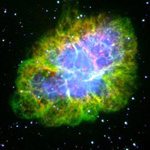CXC Home | Search | Help | Image Use Policy | Latest Images | Privacy | Accessibility | Glossary | Q&A
Chandra 101: Overview for Teachers and Students
A Look at X-Rays
What's a specific instance where Chandra will be
useful?
The Crab Nebula is an expanding cloud of gas leftover from a supernova
explosion. Compare a Chandra X-ray image (Left) and an Optical image (Right)
below.
The X-ray nebula shown in the Chandra image is about 40% as large as the optical
nebula. The X rays are more concentrated toward the center than the optical emission. Also, it seems that the X-ray image is NOT centered on the pulsar, the star remnant from the supernova. There are all sorts of interesting loops and knots in the X-ray image, some of which appear to correlate with optical features and some that do not.
Do these x-ray features change over time, as do the images in the visible wavelengths? And how fast are these knots moving? Perhaps future observations with Chandra will provide the answer. With its incomparably better imaging capabilities, we may some day be able to see the shock waves made by the pulsar as it feeds energy into the Nebula.




